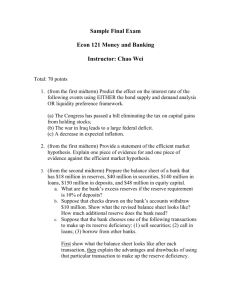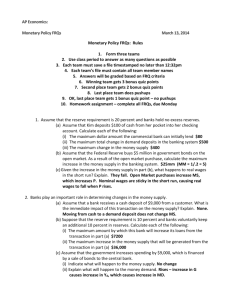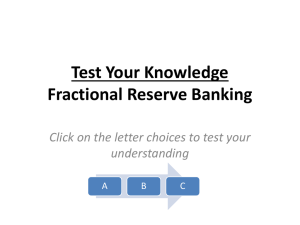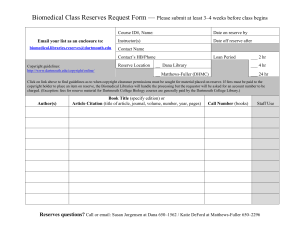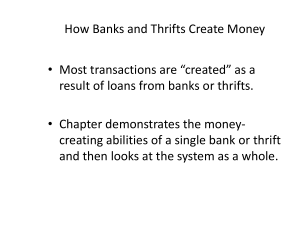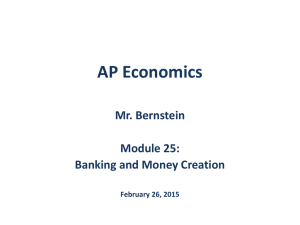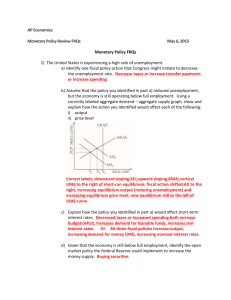AP Economics Unit 3 Practice Exam - Money & Monetary Policy
advertisement
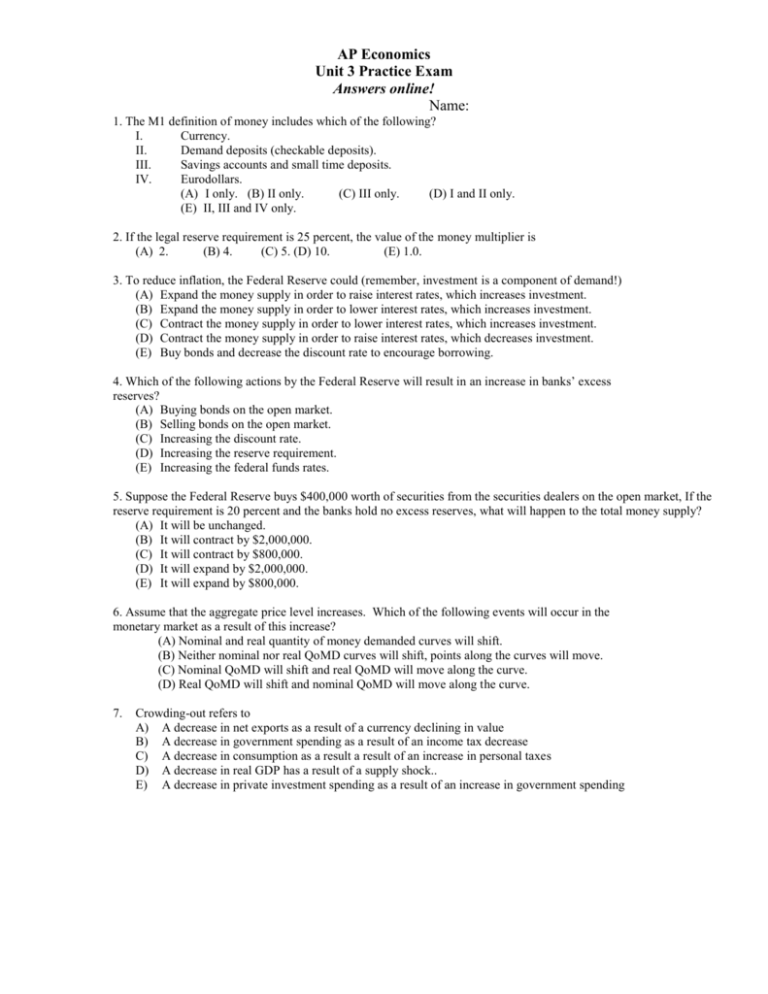
AP Economics Unit 3 Practice Exam Answers online! Name: 1. The M1 definition of money includes which of the following? I. Currency. II. Demand deposits (checkable deposits). III. Savings accounts and small time deposits. IV. Eurodollars. (A) I only. (B) II only. (C) III only. (D) I and II only. (E) II, III and IV only. 2. If the legal reserve requirement is 25 percent, the value of the money multiplier is (A) 2. (B) 4. (C) 5. (D) 10. (E) 1.0. 3. To reduce inflation, the Federal Reserve could (remember, investment is a component of demand!) (A) Expand the money supply in order to raise interest rates, which increases investment. (B) Expand the money supply in order to lower interest rates, which increases investment. (C) Contract the money supply in order to lower interest rates, which increases investment. (D) Contract the money supply in order to raise interest rates, which decreases investment. (E) Buy bonds and decrease the discount rate to encourage borrowing. 4. Which of the following actions by the Federal Reserve will result in an increase in banks’ excess reserves? (A) Buying bonds on the open market. (B) Selling bonds on the open market. (C) Increasing the discount rate. (D) Increasing the reserve requirement. (E) Increasing the federal funds rates. 5. Suppose the Federal Reserve buys $400,000 worth of securities from the securities dealers on the open market, If the reserve requirement is 20 percent and the banks hold no excess reserves, what will happen to the total money supply? (A) It will be unchanged. (B) It will contract by $2,000,000. (C) It will contract by $800,000. (D) It will expand by $2,000,000. (E) It will expand by $800,000. 6. Assume that the aggregate price level increases. Which of the following events will occur in the monetary market as a result of this increase? (A) Nominal and real quantity of money demanded curves will shift. (B) Neither nominal nor real QoMD curves will shift, points along the curves will move. (C) Nominal QoMD will shift and real QoMD will move along the curve. (D) Real QoMD will shift and nominal QoMD will move along the curve. 7. Crowding-out refers to A) A decrease in net exports as a result of a currency declining in value B) A decrease in government spending as a result of an income tax decrease C) A decrease in consumption as a result a result of an increase in personal taxes D) A decrease in real GDP has a result of a supply shock.. E) A decrease in private investment spending as a result of an increase in government spending 8. If the amount of money demanded exceeds the amount supplied, the: A. demand-for-money curve will shift to the left. B. money supply curve will shift to the right. C. interest rate will rise. D. interest rate will fall. 9. Gold, baseball cards and stones are examples of A. Fiat money B. commodity money C. commodity-backed money D. commodity and fiat money E. Commodity-backed and fiat money Answer the next questions10-12 on the basis of the following consolidated balance sheet for the commercial banking system. Assume the required reserve ratio is 30 percent. All figures are in billions. Assets Reserves $ 51 Securities 100 Loans 109 Property 10 Liabilities and net worth Checkable Deposits $140 Capital Stock 130 10. The commercial banking system has excess reserves of: A. $9 billion B. $7 billion C. $6.1 billion D. $ 5billion E. $0 11. The maximum by which the commercial bank can expand the money supply by lending is: A. $30 billion B. $23.1 billion C. $27 billion D. $15 billion E. Zero 12. If the commercial banking system actually loans the maximum amount it is able to lend: A. B. C. D. reserves and deposits equal to that amount will be gained. excess reserves will be $2.6 billion. excess reserves will fall to $1.7 billion. excess reserves will be reduced to zero. 13. Suppose the Fed wants to reduce the money supply by $400 billion to drive up interest rates and dampen inflation.(Remember the Fed. Reserve requirement is 10%) To accomplish this it could: A) sell $20 billion of U.S. securities to the banks. B) buy $20 billion of U.S. securities from the banks. C) sell $40 billion of U.S. securities to the banks. D) buy $40 billion of U.S. securities from the banks. Use the following exhibit to answer questions 14-15 Assets Liabilities RR $30,000 $200,000 DD ER $ 0 Loans? 14. The required reserve is A) .10 B) .15 C) .20 D) .25 E) Unknown 15. The total outstanding loans of this bank is A) $230, 000 B) $200,000 C) $170,000 D) $30,000 E) Unknown 16. Sam receives his $1, 000 monthly “tips” in cash and deposits it in the bank above. The bank is now able to grant new loans in the amount of: A) $700.00 B) $800 C) $850 D) $1,000 E) No loans can be created Free Response 1. Assume that the Federal Reserve System sells bonds in the open market, and that commercial banks hold no excess reserves. (a) Explain in detail how the Federal Reserve's action affects the commercial banks' reserves and the interest rates. (b) Show graphically what happens in the money market when the Federal Reserve sells bonds. (c) Explain the effects of the Federal Reserve's action on each of the following. (i) Aggregate demand (ii) Output (iii) The price level 2. Janet Smith deposits $1,000 of her cash holdings in her checking account at First Federal Bank. The reserve requirement is 20 percent and the bank has no excess reserves. (a) (b) © What is the immediate effect of her deposit on the money supply? Explain why. What is the maximum amount of money First Federal can initially loan out? Explain how you determined this amount. What is the maximum amount of money the entire banking system can create? Explain how you determined this amount.


